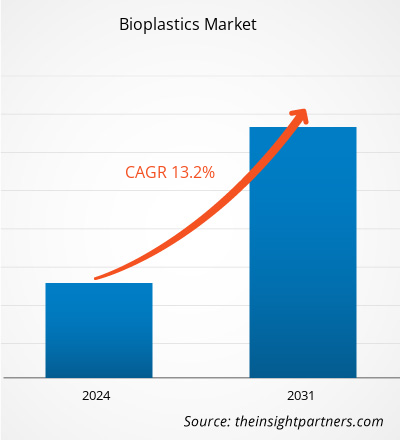生物塑料市场规模预计将从 2023 年的 72 亿美元增至 2031 年的 194.3 亿美元。预计 2023-2031 年市场复合年增长率将达到 13.2%。对创新和技术进步的日益关注可能仍是生物塑料市场的主要趋势。
生物塑料市场分析
日益增长的环境问题和全球减少污染的努力正在推动全球包装行业对可生物降解塑料的需求。此外,由于对不同医疗保健产品的需求不断增长,包装行业对生物塑料的需求预计将增长。此外,制造商很容易制造生物塑料包装,因为由生物聚合物生产的包装通常可以采用标准塑料加工技术生产。包装行业对环保塑料的需求不断增长,预计是预测期内推动全球生物塑料市场增长的主要因素。
生物塑料市场概况
生物塑料是由可再生生物质来源制成的塑料材料,其中包括植物油脂、玉米淀粉、稻草、木屑、锯末和回收的食物垃圾等。生物塑料的使用越来越多,以减少窒息地球和污染环境的塑料垃圾问题;此外,生产生物塑料所需的能源比传统石油塑料少 65%。
定制此报告以满足您的需求
您可以免费定制任何报告,包括本报告的部分内容、国家级分析、Excel 数据包,以及为初创企业和大学提供优惠和折扣
- 获取此报告的关键市场趋势。这个免费样品将包括数据分析,从市场趋势到估计和预测。
生物塑料市场驱动因素和机遇
各应用领域对生物塑料的需求不断增长
各个应用领域对生物塑料的需求不断增长,这是生物塑料市场的重要驱动力。生物塑料用于众多终端行业,如医疗、汽车和运输、包装、农业、消费品、纺织、建筑等。在医疗领域,生物塑料在伤口管理、组织工程、药物输送、矫形器械以及纤维和多孔支架制造方面有着广泛的应用。在汽车领域,生物塑料减少了对化石资源的依赖,降低了制造成本,并显著减少了碳足迹。此外,生物塑料还用于粉饼、面霜、口红和饮料瓶等化妆品硬质包装。
政府对传统塑料使用的严格法律法规
全球许多国家都实施了与塑料相关的法律法规。各国都在努力禁止一次性塑料,并推广可持续的替代品。这将有助于减轻对人类生活和环境的不良影响。因此,政府对传统塑料使用的严格法律法规预计将为生物塑料市场增长提供更多有利可图的机会。
生物塑料市场报告细分分析
有助于得出生物塑料市场分析的关键部分是类型和应用。
- 根据类型,市场分为可生物降解和不可生物降解。2023 年,可生物降解部分占据了更大的市场份额。
- 根据应用,市场分为包装、农业、消费品、汽车和运输、纺织品、建筑和施工等。包装领域在 2023 年占据了最大的市场份额。
生物塑料市场份额按地区分析
生物塑料市场报告的地理范围主要分为五个地区:北美、亚太、欧洲、中东和非洲、南美和中美。
全球市场由亚太地区主导。欧洲是全球生物塑料市场份额的第二大贡献者。在北美,生物塑料以塑料瓶和塑料袋的形式广泛用于包装行业。该地区生物塑料的生产和消费预计将增长,主要是在食品包装应用方面。与传统塑料不同,生物塑料来自可再生资源。由于对基础设施、研发活动和新生产设施的大量投资,该地区的汽车行业是全球最先进的行业之一。生物聚酰胺 (Bio-PA)、聚乳酸 (PLA) 和生物基聚丙烯 (Bio-PP) 是汽车制造中广泛使用的生物塑料。这些因素正在推动汽车生物塑料市场的增长。
生物塑料市场区域洞察
Insight Partners 的分析师已详尽解释了预测期内影响生物塑料市场的区域趋势和因素。本节还讨论了北美、欧洲、亚太地区、中东和非洲以及南美和中美洲的生物塑料市场细分和地理位置。

- 获取生物塑料市场的区域特定数据
生物塑料市场报告范围
| 报告属性 | 细节 |
|---|---|
| 2023 年的市场规模 | 72亿美元 |
| 2031 年市场规模 | 194.3亿美元 |
| 全球复合年增长率(2023 - 2031) | 13.2% |
| 史料 | 2021-2022 |
| 预测期 | 2024-2031 |
| 涵盖的领域 | 按类型
|
| 覆盖地区和国家 | 北美
|
| 市场领导者和主要公司简介 |
|
生物塑料市场参与者密度:了解其对业务动态的影响
生物塑料市场正在快速增长,这得益于终端用户需求的不断增长,而这些需求又源于消费者偏好的不断变化、技术进步以及对产品优势的认识不断提高等因素。随着需求的增加,企业正在扩大其产品范围,进行创新以满足消费者的需求,并利用新兴趋势,从而进一步推动市场增长。
市场参与者密度是指在特定市场或行业内运营的企业或公司的分布情况。它表明在给定市场空间中,相对于其规模或总市场价值,有多少竞争对手(市场参与者)存在。
在生物塑料市场运营的主要公司有:
- 帝人株式会社
- 东丽株式会社
- 沙特基础工业公司
- 巴斯夫
- 总 Corbion PLA
- 巴西石化公司
免责声明:上面列出的公司没有按照任何特定顺序排列。

- 了解生物塑料市场主要参与者概况
生物塑料市场新闻及最新发展
生物塑料市场通过收集一级和二级研究后的定性和定量数据进行评估,其中包括重要的公司出版物、协会数据和数据库。以下是言语和语言障碍市场的发展和策略列表:
- 全球化工行业领导者 SABIC 今天推出了一系列新的生物基 ULTEM™ 树脂,这些树脂具有可持续性优势,同时提供与现有 ULTEM 材料完全相同的高性能和可加工性。这些突破性的聚醚酰亚胺 (PEI) 材料是业内首批经过认证的可再生、高性能、无定形聚合物。(来源:SABIC、新闻和媒体/最新消息/2021 年 10 月)
- 东丽工业公司今天宣布,该公司已开发出一种尼龙 510 (N510) 纤维,该纤维含有 100%“生物基合成聚合物含量”,符合塑料生物基含量国际标准 ISO 16620-1: 2015 第 3.1.5 节的定义。Ecodear N510 将成为东丽 Ecodear 系列中首款 100% 植物基尼龙纤维。(来源:东丽工业公司,新闻编辑室/2022 年 1 月)
生物塑料市场报告覆盖范围和交付成果
“生物塑料市场规模和预测(2021-2031)”报告对以下领域进行了详细的市场分析:
- 范围内所有主要细分市场的全球、区域和国家层面的市场规模和预测
- 市场动态,如驱动因素、限制因素和关键机遇
- 未来的主要趋势
- 详细的波特五力分析和 SWOT 分析
- 全球和区域市场分析涵盖关键市场趋势、主要参与者、法规和最新市场发展
- 行业格局和竞争分析,涵盖市场集中度、热点图分析、知名参与者和最新发展
- 详细的公司简介
- 历史分析(2 年)、基准年、预测(7 年)及复合年增长率
- PEST和SWOT分析
- 市场规模、价值/数量 - 全球、区域、国家
- 行业和竞争格局
- Excel 数据集
近期报告
相关报告
客户评价
购买理由
- 明智的决策
- 了解市场动态
- 竞争分析
- 客户洞察
- 市场预测
- 风险规避
- 战略规划
- 投资论证
- 识别新兴市场
- 优化营销策略
- 提升运营效率
- 顺应监管趋势





















 获取免费样品 - 生物塑料市场
获取免费样品 - 生物塑料市场